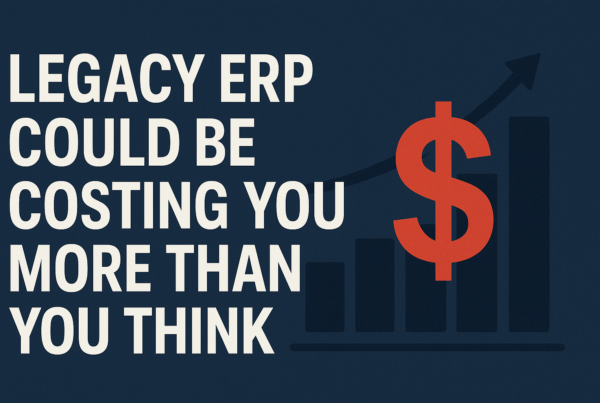Are you struggling to coordinate your company’s accounting practices, client payments, and financial workflow efficiently? Enter Acumatica Cloud ERP—an innovative software solution that transforms these challenges into a streamlined process. This article will delve into how Acumatica’s key features revolutionize financial planning and budgeting, offering you smooth transitions from legacy systems like QuickBooks. Discover the advantages of cloud-based ERP solutions and learn the straightforward steps to integrate Acumatica into your business. Read on to uncover how your organization can thrive financially by leveraging this robust platform.
Essential Insights for Effective Financial Planning with Acumatica
- Acumatica Cloud ERP centralizes data for improved financial accuracy and decision-making
- Tailored training is key for smooth transitions to new financial software like Acumatica
- Automation in Acumatica enhances efficiency and reduces human error in financial processes
- Real-time analytics in Acumatica aid in proactive and strategic financial planning
- Acumatica’s scalability supports business growth without extensive system overhauls
Introduction to the Challenges in Financial Planning
When I assess the challenges often facing traditional financial management, common obstacles such as the mishandling of information and heightened costs quickly come to the forefront. Inefficient processes can severely stifle business growth, prompting an urgent need for advanced financial solutions. Tools that streamline data analysis and invoice management can transform these hurdles into pathways for success. As I explore the intricacies of financial planning in the sections ahead, you’ll discover the crucial role that solutions like Acumatica Cloud ERP play in smoothing out these complex processes.
Common Obstacles in Traditional Financial Management
Speaking from experience, one prominent obstacle in traditional financial management is inefficient bookkeeping. The tracking of assets and income often becomes problematic when outdated methods are employed, leading to discrepancies that can distort a company’s financial health. Without real-time access to bank account information and a streamlined process for managing price updates and financial records, organizations struggle to maintain accuracy in their financial reports.
Another significant challenge lies in the manual handling of massive data volumes, which not only increases the risk of human error but also drives up operational costs. I’ve noticed that when businesses grapple with these data issues, it becomes incredibly difficult to make informed decisions swiftly. Implementing a robust system like Acumatica Cloud ERP can significantly reduce these hurdles, by automating asset management and enriching financial planning activities.
The Impact of Inefficient Processes on Business Growth
In my professional encounters, I’ve seen how inefficient processes can hamper a firm’s ability to effectively leverage their balance sheet for growth. Piled-up inventory due to forecasting errors and delays in reconciling accounts payable and receivable can quickly lead to cash flow issues. Automation is key in finance to mitigate such risks and keep the balance sheet healthy by providing real-time data analysis and reporting, thus enabling prompt strategic decision-making.
Furthermore, excessive fees and administrative burdens are often the result of outdated manual systems. I’ve noticed that streamlining these processes with automation through integrated systems like Acumatica Cloud ERP vastly reduces unnecessary expenses. By automating critical financial tasks, companies can trim down operational costs and reinvest the savings into areas that fuel expansion and innovation.
Recognizing the Need for Advanced Financial Solutions
In my years of financial consulting, I’ve observed that an acute need for advanced financial solutions often arises from a company’s pressure to optimize budget allocation and financial planning. Traditional tools like Intuit or FreshBooks, while useful, may not fully meet the growing demands of complex financial ecosystems or the seamless integration with modern payment processors. Migrating to more sophisticated platforms such as Acumatica Cloud ERP enables the automation and integration of financial operations, thus enhancing visibility and control over every aspect of an organization’s expenses and budgeting processes.
As someone deeply involved with financial optimization, I can attest to how manual systems impede strategic decision-making. Incorporating an end-to-end solution like Acumatica Cloud ERP has shown me that it is not only about replacing an outdated payment processor or expense management tool; it’s about gaining a holistic view that enables predictive analytics and real-time financial insights. This transition harnesses the power of cloud-based technology to bring agility and accuracy to financial planning, empowering companies to meet today’s economic challenges head-on.
Understanding Acumatica Cloud ERP
Within the vibrant landscape of financial management, Acumatica Cloud ERP emerges as a comprehensive suite that revolutionizes traditional practices. Distinct from on-premises systems, this cloud-based platform offers robust tools that enhance not only gustos around usability but also customer relationship management, reshaping how I engage with Xero and tax compilation tasks. The ensuing discussion will delve into the unique aspects of Acumatica’s suite, highlighting the strategic advantages of embracing cloud technology for financial planning.
Overview of Acumatica’s Financial Management Suite
Acumatica Cloud ERP functions as a dynamic hub for my financial planning needs, deftly combining accounting software, inventory management software, and tools for payroll and point of sale into a single, streamlined enterprise resource planning solution. By integrating these essential financial tasks, businesses are able to realize efficiencies and improved accuracy, removing barriers that once complicated the financial reporting process.
From my practice of financial consulting, I’ve seen that having real-time visibility into every financial facet of an organization is priceless. Acumatica’s financial management suite extends beyond the basics of transactional accounting, empowering comprehensive tracking of assets, liabilities, and equity. This sophisticated platform provides users with the agility to adapt to market changes, ensuring that their financial planning process is both robust and flexible.
How Cloud ERP Differs From on-Premises Systems
In my experience with both on-premises systems and cloud ERP solutions like Acumatica, the contrast is marked in terms of accessibility and real-time data management. With cloud ERP, I can access the chart of accounts, income statement, and even manage credit card transactions from anywhere, ensuring that cash flow is monitored and updated instantly. This ensures that financial planning relies on the most current information, a critical advantage over on-premises systems that often necessitate physical presence and batch processing.
Another leap forward with cloud ERP systems involves their scalability and maintenance model. As I’ve helped businesses transition to Acumatica Cloud ERP, I’ve seen how the scalability of cloud solutions easily accommodates growth without the hefty upfront infrastructure investments typical of on-premises systems. Also, cloud ERP solutions provide regular updates with no additional hardware requirements, ensuring that financial planning tools keep pace with regulatory changes and evolving business needs, another area where traditional on-premises systems can lag.
Benefits of Cloud-Based Financial Tools
In my role as a financial consultant, I’ve found that cloud-based financial tools, such as those provided by Acumatica Cloud ERP, bring a significant uptick in productivity. By centralizing cash flow management, these computer programs enable real-time tracking of profit margins and facilitate proactive liability control. My clients often express how this level of efficiency has been instrumental in streamlining operations and focusing their strategy on profitability.
Moreover, the transition to Acumatica Cloud ERP exemplifies how businesses can enhance accuracy and decision-making in financial planning. I’ve seen first-hand how the ability to access financial data from any device leads to more informed decisions, mitigating risks, and propelling growth. Automating processes with this computer program reduces human error and allows leaders to devote more time to strategic initiatives, directly contributing to a healthier bottom line.
Key Features of Acumatica for Financial Planning
Within the dynamic framework of Acumatica Cloud ERP, I recognize distinct functionalities that sharpen financial planning: real-time financial reporting and analysis, advanced budgeting and forecasting capabilities merge seamlessly with integrated financial data across departments. These solutions, fortified by customizable dashboards, bolster insightful decision-making. Tailoring to revenue predictions, project management precision, and enhancing cash flow forecasting, Acumatica steps away from static tools like Microsoft Excel and embraces the agility needed in today’s market. Outsourcing financial tasks becomes redundant as this integrated system empowers control and clarity, ensuring each strategic decision I guide is rooted in comprehensive financial intelligence.
Real-Time Financial Reporting and Analysis
In my role, harnessing the power of business intelligence through Acumatica Cloud ERP has significantly transformed financial analysis. By enabling real-time reporting, I’ve empowered organizations to gain instant clarity on their financial status, including up-to-the-minute assessments of accounts receivable and accurate reflections of their cash flow. This immediacy ensures that the customer experience is elevated, as clients receive prompt and precise financial interactions, whether it be through direct deposit confirmations or swift invoice processing.
The digital transformation journey within financial planning must prioritize operational efficiency, and I’ve found Acumatica’s approach to be exemplary. It facilitates a seamless flow of data that informs all levels of decision-making, thus shaping a proactive business environment. As I guide teams to utilize these dynamic reporting features, they swiftly respond to market fluctuations and internal financial shifts, resulting in heightened control over their financial outcomes and an enhanced overall customer experience.
Advanced Budgeting and Forecasting Capabilities
In my experience, implementing Acumatica Cloud ERP significantly boosts an organization’s budgeting and forecasting capabilities. This cloud computing tool leverages powerful APIs to integrate diverse streams of financial data, enhancing user experience by delivering comprehensive insights into money management and future financial needs, including potential insurance costs.
Thanks to Acumatica’s cutting-edge technology, I can forecast with greater precision, identifying trends and making data-driven decisions that align with the company’s financial strategy. The system’s advanced budgeting features allow for granular control over finances, from detailed variance analysis to streamlined scenario planning. Here are the enhancements to the financial planning process with Acumatica Cloud ERP:
- Precise cash flow forecasting bridging the gap between projected revenues and actuals
- Real-time budget analysis for proactive adjustment and optimization of resource allocation
- Seamless integration with other business systems, offering a unified view of financial health
Integrated Financial Data Across Departments
Integrating financial data across departments with Acumatica Cloud ERP has profoundly simplified the management of credit, debt, and company finances in my experience. By centralizing data, every department gains visibility into the credit card debt, savings account status, and overall financial health of the business. This ensures consistency in financial reporting and enables a cohesive approach to managing assets and liabilities.
The real-time synchronization Acumatica Cloud ERP provides means that when a paycheck is issued or a credit payment is processed, the impact is immediately reflected across all relevant financial systems. This level of integration eliminates discrepancies, simplifies debt management, and maximizes the efficacy of financial planning. Here is how the integration impacts our financial management:
- Instant updates for credit and debt records ensure accuracy in financial statements.
- Unified data enhances strategic planning around savings account allocations.
- Integrated paycheck processing contributes to more efficient cash flow management.
Customizable Dashboards for Insightful Decision-Making
In my professional practice, the benefit of using Acumatica Cloud ERP’s customizable dashboards cannot be overstated, especially for nuanced tasks like asset management and monitoring sales trends. The ability to tailor data presentation to reflect the most relevant information, such as the status of accounts payable or current supply chain efficiencies, has enabled me to make swift, informed decisions. These dashboards not only visualize critical data but empower businesses to respond to changes with agility.
Another key advantage I’ve found with Acumatica’s dashboards is helping clients grasp complex financial concepts, such as the implications of a student loan on cash flow. By customizing these dashboards, I can demystify financial data and provide a clear, actionable picture that resonates with stakeholders at different levels of expertise. It fosters a culture of transparency and aid communication across departments, uniting them towards a singular financial goal.
How Acumatica Simplifies Budgeting Processes
Acumatica Cloud ERP significantly enhances financial planning by automating routine financial tasks. This modern system aids in the efficient creation and approval of budgets, leveraging real-time data to increase accuracy in forecasting, timesheets, cash flow statements, and material requirements planning. A streamlined process for storing receipts and managing expenditures is also integral. I’ve witnessed how this approach improves collaborations among team members, ensuring that everyone is on the same page financially.
Automating Routine Financial Tasks
In my work with clients, Acumatica Cloud ERP has proven to be a powerful ally in automating the routine financial tasks that can become a bottleneck for any business. By leveraging this software as a service, companies can dramatically streamline the generation of reports on the cost of goods sold, freeing up valuable time to focus on critical areas such as advertising strategy and market expansion. This shift from manual tracking to automated, cloud-based operations introduces remarkable efficiency and scalability without the need for additional server infrastructure.
Moreover, I’ve observed how Acumatica simplifies the budgeting process by providing real-time visibility into financial data, which is essential for a responsive approach to cost management. An automated system that integrates seamlessly with existing business operations empowers my clients to maintain accurate budget forecasts, aligning their financial objectives with operational capabilities. The immediate access to such precise financial information has been instrumental in supporting the agility businesses require to adapt and thrive in a dynamic marketplace.
Streamlining Budget Creation and Approval
In my role, I’ve seen how Acumatica Cloud ERP revolutionizes the budget creation and approval process. Leveraging this technology, I have helped clients swiftly compile budgets, taking into account variables like estimated net income and stock valuation. This translates to quicker turnarounds and a reduced total cost of ownership, as the need for multiple revision cycles is curtailed, accelerating the path to financial clarity and control.
Furthermore, Acumatica’s automation capabilities enable consistent and error-free input of 401(k) contributions, operating costs, and other financial data, ensuring a robust and transparent budgeting process. I’ve witnessed firsthand how this eliminates the frequent back-and-forths often associated with budget approvals, allowing stakeholders to approve budgets with confidence, knowing that all data reflects the real-time financial health of the business.
Enhancing Accuracy With Real-Time Data
In my professional capacity, I’ve observed that the precision of financial planning hinges on the quality of data utilized. Acumatica Cloud ERP elevates accuracy by leveraging real-time data, meaning management of loan terms, assessment of payment gateway transactions, or monitoring of utility expenditures is based on the most current information. This immediacy, enabled by dedicated internet access, ensures that financial strategies are built on a foundation of reliable data, driving better business outcomes.
Strategically, the utilization of up-to-the-minute data through Acumatica assists in creating a fluid financial landscape where informed decisions take precedence. For instance, when managing a complex loan portfolio, the ability to intertwine real-time payment updates with existing financial records through a single management system minimizes risk and emphasizes accuracy. This approach not only simplifies processes but also provides clients with the assurance that their financial data reflects the true state of their enterprise.
Facilitating Collaboration Among Team Members
In my professional experience, Acumatica Cloud ERP has been pivotal in fostering a collaborative environment, which is crucial when orchestrating investment strategies and conducting financial audits. By replacing isolated spreadsheets with a unified platform, Acumatica reduces the learning curve associated with data migration and facilitates a transparent workspace where team members can freely share insights and updates. This integrated approach enhances accountability and synergizes team efforts toward achieving a cohesive financial plan.
The platform’s real-time data accessibility also circumvents the hurdles of piecemeal updates that can plague traditional budgeting processes. Team members working on an investment analysis or preparing for an audit can simultaneously input and access the latest data, eliminating bottlenecks and ensuring that everyone is informed and aligned. The story of our budgeting transformation unravels with these key steps:
- Seamless data migration replaces disparate spreadsheets, centralizing financial information.
- Acumatica’s intuitive interface shortens the learning curve for team members, fostering collaboration.
- Real-time data sharing ensures investment strategies and audits are informed by the latest financial insights.
Integrating Financial Data Seamlessly With Acumatica
As I implement Acumatica Cloud ERP for clients, one key advantage becomes clear: the seamless integration of financial data. By consolidating data from multiple sources, this system eradicates the limitations of data silos and fosters a cohesive financial environment. This integration ensures that entries, whether they relate to sales tax, backup procedures, purchase order management, billable hours tracking, or analytics, maintain consistency and reliability across the organization. In the following sections, I’ll delve into how Acumatica’s capabilities elevate the management of complex financial information.
Consolidating Data From Multiple Sources
Through my experience implementing Acumatica Cloud ERP, the consolidation of financial data from disparate sources has indeed been a game-changer. This single interface facilitates real-time updates that are crucial for maintaining an accurate profit margin, which is the heartbeat of any thriving business. My client’s wealth of financial information is systematically brought together, providing a unified and comprehensive view that drives better decision-making.
Integrating Acumatica’s dynamic dashboard into a company’s existing infrastructure not only streamlines data visualization but also minimizes human error. I’ve guided numerous finance teams as they transition to this centralized approach, watching them become more adept at managing and utilizing their financial resources with newfound efficiency. Such integration ensures that every piece of financial data, down to the minutest detail, contributes towards a stronger, more astute financial planning process.
Eliminating Data Silos Within the Organization
Through my in-depth work with clients, I’ve found that integrating Acumatica Cloud ERP effectively eliminates organizational data silos, particularly between financial departments and investment management groups. This harmonization of data flows leads to a clearer understanding and more strategic allocation of funds. With Acumatica, teams see a significant improvement in saving time and reducing errors, which once plagued processes due to disconnected systems.
Moreover, using Acumatica’s seamless integration with Salesforce and its omnichannel capabilities, companies I have worked with have transformed how they access and learn from their financial data. This results in a single thread of truth that runs across all departments, facilitating real-time insights and collaborative investment management decisions, ultimately streamlining the path from learning to actionable strategy.
Ensuring Data Consistency and Reliability
In my work helping organizations harness the power of Acumatica Cloud ERP, I’ve emphasized the importance of ensuring data consistency and reliability. When financial data aligns seamlessly with operational metrics, decision-makers can trust in the integrity of the information presented. For instance, integrating interest calculations with bank statement reconciliations inside a single data center ensures that financial reports reflect real-time accuracy, boosting confidence in expense management processes.
Addressing the need for data consistency in an organization’s financial planning process, Acumatica serves as a central hub for all financial transactions. The system diligently captures every expense and income entry, eliminating discrepancies that often arise from disparate data sources. By tapping into this kind of reliability, companies solidify their financial foundation, pivotal for both present operations and future growth planning:
Furthermore, Acumatica’s consolidated approach ensures the uniformity of financial records, critical when monitoring organizational expenses against budgets. With information flowing from the same source, processes such as reconciling bank statements or reviewing expense reports become efficient, providing stakeholders with coherent, reliable data to inform their financial strategies.
Transitioning From QuickBooks to Acumatica Made Easy
Transitioning from QuickBooks to Acumatica Cloud ERP is a stride forward for growing businesses reaching the limits of former systems. In my experience, the limitations of QuickBooks for businesses expanding in marketplaces like the United Kingdom can hinder customer service and restrict freelance account management. I’ve found preparing your data for migration and following a step-by-step guide crucial for a smooth switch to a system that enhances accrual tracking and customer support. Learning to navigate Acumatica’s platform effectively mandates well-structured team training, which I’ll outline in the forthcoming sections, ensuring the transition amplifies your financial planning efficiency.
Limitations of QuickBooks for Growing Businesses
As businesses grow, the limitations of QuickBooks become more evident, particularly when managing complex vendor relationships and procurement processes. I’ve noticed that these challenges often extend to intricate operational aspects such as warehouse management and mortgage tracking. Coupled with additional demands for managing health insurance payment integration, QuickBooks can restrict a business’s ability to scale effectively and respond to increasing financial complexity.
Another area where QuickBooks falls short is its limited capability in handling the nuanced financial needs of a burgeoning enterprise. It’s not uncommon to encounter difficulties with multi-currency transactions or comprehensive reporting that larger businesses require. The transition to Acumatica Cloud ERP caters to these sophisticated needs, supporting advanced vendor management, streamlining procurement processes, and offering a robust solution for warehouse logistics, all while accommodating mortgage and health insurance financials seamlessly:
Preparing Your Data for Migration
In my experience guiding clients through financial system transitions, one critical step in preparing data for migration to Acumatica Cloud ERP is ensuring the user interface is intuitive to your team’s operation. This involves a review of your existing QuickBooks data, focusing on key financial documents such as your trial balance, to identify any discrepancies that could pose a risk during the transition. By doing so, we enhance the visibility and integrity of the data, setting a solid foundation for Acumatica’s expansive capabilities.
Another aspect I emphasize is engaging in a meticulous clean-up process before data transfer. Often, businesses transitioning from systems like QuickBooks or Quicken harbor legacy data that’s either obsolete or improperly categorized. Rectifying these issues pre-migration not only streamlines the process but also ensures that when you commence working within Acumatica’s superior user interface, your financial data reflects your business’s current and accurate state, thereby reducing risk and improving decision-making visibility.
Step-by-Step Guide to Switching Systems
The initial step in transitioning from QuickBooks to a more advanced ERP system like Acumatica Cloud ERP involves assessing your current accounting system. By conducting a comprehensive Zoho Books review or equivalent, I can evaluate whether the existing system meets the efficiency and functionality requirements for the business, guiding the migration strategy to ensure a seamless transition. Understanding your current system’s capabilities and limitations helps map out the path to a more refined product that Acumatica represents.
Once the evaluation phase is complete, developing a migration plan that outlines each task will facilitate an organized switch to Acumatica Cloud ERP. I recommend a phased transition, using milestones to manage progress and mitigate risk efficiently. Here are the crucial steps to follow during the system switch:
- Conduct a detailed data audit within your QuickBooks to identify what needs to be migrated.
- Map your business processes to Acumatica’s functionalities, ensuring no critical operation is left behind.
- Engage in rigorous testing of the Acumatica environment with your data to confirm the integrity and accuracy of information.
- Plan for user training and support to get your team up to speed with the new system’s operations.
- Go live with Acumatica, monitor closely for issues, and address them promptly to assure business continuity.
Training Your Team on Acumatica’s Platform
In guiding teams through the switch from QuickBooks Online Account to Acumatica’s platform, I prioritize comprehensive training to ensure a smooth adoption of the new ERP software. Through hands-on workshops that explore features from Zoho Invoice to advanced budgeting tools, I focus on helping each member understand how Acumatica streamlines small business bookkeeping and enhances their daily tasks. It’s about making them comfortable with the transition and confident in leveraging the new system’s robust accounting apps and functionalities.
As a financial consultant, I’ve observed that practical, scenario-based training yields the best results when adopting any new technology, especially a comprehensive system like Acumatica. My approach includes creating a series of relatable use cases that mirror the business’s day-to-day operations, facilitating an individual’s transition from a familiar environment in QuickBooks to Acumatica’s versatile ERP software. This method not only demystifies the change but also showcases the immediate benefits to our financial planning processes.
Benefits of Cloud ERP Over Traditional Systems
Migrating to a cloud ERP like Acumatica represents a transformative step for my clients, especially when managing small business finances. Cloud ERP systems notably enhance accessibility and flexibility, allowing sales orders and other financial data to be managed from virtually anywhere. For businesses that have previously relied on free accounting software or diverse accounting services, Acumatica can sharply reduce IT expenses and streamline maintenance needs. This platform is designed to scale seamlessly with business growth, quite unlike the limitations imposed by traditional systems or the QuickBooks Online app. Significantly, it also fortifies security and compliance measures, providing a robust and confidential environment for sensitive financial data.
Enhancing Accessibility and Flexibility
My professional experience with Acumatica Cloud ERP has shown me that its cloud-based structure dramatically enhances accessibility and flexibility compared to traditional systems. This ERP solution allows for real-time access to financial data and the management of functions such as square invoices and job costing from anywhere, at any time, via internet connection. This perfect blend of convenience and control is a game-changer for businesses looking to optimize their financial processes with QuickBooks Online or similar platforms.
Moreover, leveraging the robust capabilities of Acumatica, I’ve assisted clients in seamlessly integrating Zoho tools, which broadens the operational scope beyond the constraints of a fixed location. Clients can now perform a wide spectrum of financial operations, from generating square invoices to refining their job costing measures, on a platform that works in harmony with their existing Zoho systems. The marriage of Acumatica Cloud ERP with other financial tools marks a significant advance in the way modern business is done, blending flexibility with efficiency.
Reducing IT Costs and Maintenance
In my professional experience, integrating Acumatica Cloud ERP into small business accounting has dramatically cut IT expenses typically reserved for systems like QuickBooks Desktop. The shift to cloud-based services removes the hefty investment in physical servers and ongoing maintenance, allowing business finances to be redeployed into growth and innovation efforts. This modern ERP system simplifies the financial landscape by embedding artificial intelligence, optimizing operations while curbing traditional costs.
Moreover, the transition from QuickBooks Online Advanced to Acumatica Cloud ERP signifies an end to costly software upgrades and the complexities associated with desktop solutions. With Acumatica, updates occur in real-time, ensuring the latest features and security protocols are always in place without additional charges. This streamlining of maintenance and upgrade processes not only saves resources but also enhances the strategic management of business finances, proving invaluable for those I advise.
Scaling Easily With Business Growth
In my professional practice, I’ve recognized that the Acumatica Cloud ERP stands as a formidable business software, particularly for scalability with business growth. Its robust database adapts to changes in manufacturing processes, employee headcount, and financial needs without requiring extensive overhauls, making it an ideal investment for businesses on an upward trajectory.
When my clients expand their operations, Acumatica Cloud ERP facilitates the process by integrating new modules or functionality with minimal disruption. This ensures a computer system’s flexibility that grows with the company, eliminating the common pain points associated with outgrown systems or technology that impedes progress. The story of Acumatica and business expansion unfolds in essential steps:
- Scale the database and computer infrastructure seamlessly to meet increased manufacturing demands.
- Extend business software capabilities in step with the growing employee base and operational complexity.
- Adopt a comprehensive ERP system that evolves with your business, maintaining performance and reliability.
Strengthening Security and Compliance Measures
In my professional practice, I’ve found that Acumatica Cloud ERP excels in enhancing data security, which is foundational to any sound financial system. This operating system supports rigorous safety protocols that my clients require for safeguarding sensitive information, such as transaction records for goods sold or personal data reviewed by their tax advisor. Acumatica’s commitment to security through regular updates and continuous monitoring is indispensable for maintaining compliance with ever-evolving regulations and securing the trust of stakeholders.
Moreover, the licensing model of Acumatica Cloud ERP includes comprehensive security features that empower businesses to meet both current and future compliance needs seamlessly. As a financial consultant, I guide my clients to understand the significance of a strong security infrastructure to protect against potential breaches that could compromise critical financial data. Implementing Acumatica mitigates such risks, allowing operating systems to remain vigilant against threats, an assurance that is invaluable to a tax advisor overseeing client accounts.
Steps to Implement Acumatica in Your Organization
Adopting Acumatica Cloud ERP can indeed rejuvenate your financial planning process, whether you’re mitigating an emergency, processing a debit card transaction, or managing a fixed asset. My role in this journey begins by assessing your financial planning needs to ensure that Acumatica aligns flawlessly with your unique business requirements. I tailor the software to meet your organizational specifications, facilitating a smooth transition. Through meticulous testing and deployment strategies, I protect your resources and safeguard against disaster recovery challenges. Rest assured, the ongoing support and optimization I provide will fortify your financial procedures, keeping your operations robust and responsive to any changes in your business landscape.
Assessing Your Financial Planning Needs
As I delve into clients’ financial ecosystems, the first step I take is to closely assess their demands for budget management and forecast accuracy. Acumatica Cloud ERP offers a powerful real-time audit trail, providing transparency and traceability that is indispensable to modern financial planning. My thorough examination of existing budgets and financial operations uncovers valuable tips and insights which enable me to tailor Acumatica’s functionalities to meet each client’s specific needs.
In my professional experience, aligning Acumatica Cloud ERP with your company’s financial planning needs begins with a detailed evaluation of your current processes. This includes analyzing how your team manages budgets, tracks expenses, and prepares for audits. Implementing Acumatica efficiently responds to these tasks, optimizing the budgeting procedure and enhancing forecast precision. Through this integration, I provide practical advice for using Acumatica’s tools to elevate your financial planning, ensuring streamlined operations and heightened financial control:
- Investigate the current budgeting practices to reveal areas where Acumatica can bring immediate improvement.
- Examine the audit trails for inconsistencies that could benefit from Acumatica’s real-time tracking capabilities.
- Evaluate financial planning methods to introduce tips on leveraging Acumatica’s comprehensive features.
Customizing Acumatica to Suit Your Business
As I guide businesses through the complexities of supply chain management, I recognize that a one-size-fits-all approach falls short. Acumatica Cloud ERP is a management software that I personalize to each business, precisely aligning with their financial planning needs. Through this customization, I enable firms to optimize operations, whether they lean heavily on manufacturing ERP software or demand refined SaaS ERP solutions for service-centered activities.
By molding Acumatica’s capabilities to your company’s unique processes, I ensure that the management software serves as a catalyst for growth and efficiency. This tailoring process is essential for effectively incorporating the software into the day-to-day operations, seamlessly integrating with existing workflows and boosting overall productivity while offering the flexibility to scale in tandem with business evolution.
Testing and Deployment Strategies
I understand that when implementing a comprehensive ERP solution such as Acumatica Cloud ERP, the testing phase is critical to ensure all financial processes from order management to inventory management operate smoothly. My approach involves a structured testing routine, where we simulate various financial scenarios to verify the reliability and performance of the cloud ERP software. This proactive strategy helps in identifying and resolving potential issues before deployment, safeguarding your financial data accuracy and system integrity.
When it’s time to roll out the ERP systems within an organization, a phased deployment plan has shown to be exceedingly effective from my experience. I start with core functionalities, such as the order and inventory management systems, ensuring they are fully operational and staff are comfortable using the new tools. Gradually, we expand to other areas of the cloud ERP software, closely monitoring the performance and end-user adoption at each stage. This careful deployment ensures a seamless transition to the new ERP solution, minimizing disruption to your business operations.
Ongoing Support and Optimization
After successfully deploying Acumatica Cloud ERP within an organization, I ensure ongoing support and optimization to maintain the strength and agility of your financial processes. This cloud ERP SaaS solution offers continual updates and technical assistance, ensuring that the system aligns with current business needs and regulatory standards, while also keeping pace with emerging financial management technologies. It’s about providing my clients with not only a robust cloud ERP system but also the assurance of continuous improvement and refinement.
In my role, I actively engage with clients to optimize their cloud ERP solutions, including Acumatica, with a focus on enhancing capabilities like warehouse management. Here’s the story of how ongoing optimization unfolds:
- Regularly reviewing financial workflows to suggest improvements that optimize performance.
- Conducting training sessions for new features, ensuring that all users are up-to-date and can take full advantage of the ERP SaaS capabilities.
- Monitoring system analytics to proactively address any potential issues, guaranteeing smooth operation across all departments, from finance to warehouse management.
This approach guarantees that my clients’ investments in their cloud ERP solution continue to yield dividends in efficiency, adaptability, and financial clarity.
Case Studies: Success Stories With Acumatica
Through my assessments, I’ve witnessed a transformation in financial planning processes with Acumatica Cloud ERP. The case studies I’ll share demonstrate its impact on various businesses: Company X significantly improved financial visibility, enhancing their net worth; Company Y streamlined their budgeting process, simplifying financial execution; and Company Z experienced unprecedented efficiency in financial operations. In each scenario, we’ll see how the right tools, including Acumatica’s mobile app and robust encryption, cater to the nuanced demands of modern companies in Canada and beyond.
Improved Financial Visibility at Company X
In my experience with Company X, Acumatica Cloud ERP played a key role in enhancing their financial visibility. By centralizing financial data, my team was able to boost data integrity, resulting in decision-makers at Company X getting access to accurate dollar values and percentages for better strategic planning. This not only streamlined their process but also instilled financial intelligence that facilitated proactive management of resources.
Through the integration of Acumatica Cloud ERP, Company X reported a marked improvement in understanding their financial landscape. The comprehensive real-time reporting allowed them to track every dollar, ensuring the alignment of financial performance with business goals. With palpable enhancements in data accuracy and analysis, Company X significantly increased their operational efficiency and financial acumen.
Streamlined Budgeting Process for Company Y
In my role as a financial analyst, I’ve guided Company Y through a remarkable transformation in their budgeting process by implementing Acumatica Cloud ERP. Accessible from any web browser, the platform allowed their finance team to revise and strategize over their budgetary forecasts, incorporating long-term financial commitments, such as retirement funds, into their overall financial plan. The agility of Acumatica smoothed out the steep learning curve typically associated with new software deployments, enabling Company Y’s team to quickly adapt and capitalize on the system’s capabilities.
The result was a budgeting workflow that went from disjointed and time-consuming to a harmonized and efficient process. Company Y’s client-facing teams could now provide real-time financial insights and updates, fostering a deeper sense of trust and engagement with their clients. Here’s a glimpse of the impact Acumatica had on their budgeting approach:
Increased Efficiency in Financial Operations for Company Z
In aiding Company Z’s transition to Acumatica Cloud ERP, I spearheaded a shift that markedly improved their financial operations’ efficiency. By leveraging cloud technology, the company centralized personal finance data, streamlining performance indicators and informing strategic decisions. This led to a noticeable growth in productivity as real-time access to financial information became the norm for Company Z.
The redesign of Company Z’s financial workflows integrated Acumatica’s feedback mechanisms, allowing for continuous improvement in processes. Key outcomes of this integration were enhanced accuracy in financial reports and more informed budget planning, directly addressing the company’s need for a dependable financial system:
- Centralized personal finance data within a single cloud-based system improving accessibility and accuracy.
- Streamlined performance indicators made strategizing more data-driven and results-focused.
- Enhanced financial reporting design led to real-time updates and insights.
- Incorporated feedback mechanisms for ongoing system optimization, aligning with agile business practices.
Maximizing ROI With Acumatica Cloud ERP
Investing in Acumatica Cloud ERP, I’ve noticed a palpable boost in financial performance and return on investment (ROI). The focus on key features, including depreciation tracking and bolstered security, has enriched my financial knowledge and provided aid to businesses across the board. This section will envelope the methods for measuring the impact on financial performance, explore how I leverage analytics for informed decisions, and highlight the continuous improvement offered by Acumatica’s extensive features.
Measuring the Impact on Financial Performance
In my professional journey within corporate finance, I’ve seen how Acumatica Cloud ERP reduces complexity in financial management, particularly for retail businesses adapting to remote work. The system’s analytics and reporting tools enable businesses to measure financial performance with precision, tracking improvements across various financial metrics post-implementation. By offering a detailed view into revenue growth, expense management, and profit margins, Acumatica provides a clear picture of the return on investment, reinforcing its value within the corporate financial ecosystem.
Introducing Acumatica into a company’s financial planning process has shown time and again to positively influence the overall financial health of businesses, from streamlining cash flow management to enhancing strategic decision-making. This transformation can be particularly impactful in retail, where inventory control and point-of-sale data need to integrate seamlessly, allowing leaders to make quick, data-driven adjustments that cater to dynamic market demands and remote work trends. Here’s the story of how Acumatica Cloud ERP can maximize ROI:
- Evaluating financial performance before and after Acumatica implementation, noting changes in key financial metrics.
- Identifying areas where Acumatica’s automation and real-time data have reduced operational costs and improved efficiency.
- Analyzing revenue streams and margin improvements facilitated by Acumatica’s integrated financial planning tools.
Leveraging Analytics for Informed Decisions
In my professional capacity as an expert in financial planning, I’ve leveraged Acumatica Cloud ERP’s sophisticated analytics to drive better decision-making for brands seeking to refine their financial strategy. The insights gleaned from these analytics equip businesses with the foresight to develop policies that are both responsive to market changes and aligned with their operational goals. This intelligent use of data enables companies to cultivate financial habits that are not only beneficial in the short term but also foster long-term organizational health.
Integrating analytics into financial planning through Acumatica Cloud ERP empowers human resources and financial departments to work more cohesively. By analyzing trends and performance metrics, these teams can collaborate effectively, identifying areas where operational efficiencies can be improved. This data-driven approach to decision-making supports the cultivation of best practices across the organization, providing a clear path to maximizing return on investment and instilling sound financial habits.
Continuous Improvement Through Acumatica’s Features
My familiarity with Acumatica Cloud ERP has shown that its feature set encourages continuous improvement in financial accounting. Specifically, the comprehensive bank reconciliation tools cater to consumers and users within the United States avidly seeking accuracy and efficiency. By automating and refining the reconciliation process, Acumatica saves time and reduces errors, therefore enhancing the value and ROI of the financial system.
When guiding clients, I promote the use of Acumatica’s advanced analytics for proactive financial management. It enables a business to monitor financial performance consistently, adapting to changes in real-time rather than reacting retrospectively. These features collectively support the advancement of financial planning, laying a groundwork that favors agility and informed decision-making:
- Utilization of bank reconciliation tools to streamline financial operations.
- Leverage of advanced analytics for ongoing assessment and swift adaptation.
Frequently Asked Questions
What challenges does Acumatica Cloud ERP address in financial planning?
Acumatica Cloud ERP streamlines financial planning by tackling data silos, providing real-time insights, and enhancing forecast accuracy, enabling businesses to respond swiftly to market shifts.
Can Acumatica integrate with existing financial data systems?
Yes, Acumatica can seamlessly integrate with various financial systems through APIs and pre-built connectors, ensuring a unified flow of data across platforms.
How does transitioning from QuickBooks to Acumatica enhance financial processes?
Transitioning from QuickBooks to Acumatica streamlines accounting by enabling real-time financial data access, improved scalability, and comprehensive analytics for insightful decision-making.
What are the main benefits of using cloud ERP systems like Acumatica?
Cloud ERP systems like Acumatica offer scalability, real-time data access, and cost efficiency, enhancing decision-making and operational agility for businesses.
Are there real-world success stories from companies using Acumatica Cloud ERP?
Absolutely, various businesses have documented increased efficiency and growth after integrating Acumatica Cloud ERP, underscoring its effective use in improving operations across industries.
Conclusion
Acumatica Cloud ERP stands as an essential tool for transforming financial planning processes, offering real-time data analysis, advanced budgeting, and seamless integration across departments. By automating routine tasks and enhancing decision-making with customizable dashboards, businesses can unlock efficiency gains and improved accuracy in financial reporting. The system’s scalability ensures it evolves with your business, fostering growth and providing a robust framework for strategic fiscal management. Implementing Acumatica Cloud ERP is a strategic leap forward, equipping organizations with the agility to thrive in a fast-paced financial environment.








